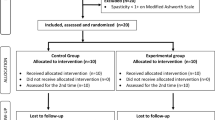Abstract
Objective
To describe the relationship between changes of cortico-spinal excitability and motor recovery of the affected hand after stroke.
Methods
Eighteen hemiparetic stroke patients with a severe-to-mild upper limb motor impairment were randomized. Cortico-spinal excitability measures (resting motor thresholds and motor evoked potentials) obtained from a distal (abductor pollicis brevis) and proximal (biceps brachii) upper limb muscle were assessed for both hemispheres. Motor function of the affected hand was tested by the Wolf Motor Function and Action Research Arm tests. The evaluations were performed at baseline and weekly over 7 weeks of in-patient neurological rehabilitation.
Results
Severe hand dysfunction was associated with a strong suppression of ipsilesional cortico-spinal excitability and a shift of excitability towards the contralesional hemisphere. Mild hand impairment was associated with a shift of cortico-spinal excitability towards the ipsilesional hemisphere. Favorable motor recovery correlated with an increase of ipsilesional cortico-spinal excitability.


Similar content being viewed by others
References
Go AS, Mozaffarian D, Roger VL, Benjamin EJ et al (2013) Heart disease and stroke statistics—2013 update: a report from the American Heart Association. Circulation 127:e6–e245
Van der Lee JH, De Groot V, Beckerman H et al (2001) The intra- and interrater reliability of the action research arm test: a practical test of upper extremity function in patients with stroke. Arch Phys Med Rehabil 82:14–19
Medical Research Council (1981) Aids to the examination of the peripheral nervous system. Memorandum No. 45. Her Majesty’s Stationery Office, London
Folstein MF, Folstein SE, McHugh PR (1975) “Mini-mental state”. A practical method for grading the cognitive state of patients for the clinician. J Psychiatr Res 12:189–198
Van Swieten JC, Koudstaal PJ, Visser MC, Schouten HJ, van Gijn J (1988) Interobserver agreement for the assessment of handicap in stroke patients. Stroke 19:604–607
Brott T, Adams HP Jr, Olinger CP et al (1989) Measurements of acute cerebral infarction: a clinical examination scale. Stroke 20:864–870
Nowak DA, Grefkes C, Dafotakis M et al (2007) Dexterity is impaired at both hands following unilateral subcortical middle cerebral artery stroke. Eur J Neurosci 25:3173–3184
Wolf SL, Catlin PA, Ellis M et al (2001) Assessing Wolf motor function test as outcome measure for research in patients after stroke. Stroke 32(7):1635–1639
Brouwer BJ, Schryburt-Brown K (2006) Hand function and motor cortical output poststroke: are they related? Arch Phys Med Rehabil 87:627–634
Takeuchi N, Tada T, Chuma T, Matsuo Y, Ikoma K (2007) Disinhibition of the premotor cortex contributes to a maladaptive change in the affected hand after stroke. Stroke 38:1551–1556
Traversa R, Cicinelli P, Oliveri M et al (2000) Neurophysiological follow-up of motor cortical output in stroke patients. Clin Neurophysiol 111:1695–1703
Fregni F, Boggio PS, Valle AC, Rocha RR et al (2006) A sham-controlled trial of a 5-day course of repetitive transcranial magnetic stimulation of the unaffected hemisphere in stroke patients. Stroke 37:2115–2122
Lüdemann-Podubecká J, Bösl K, Theilig S, Wiederer R, Nowak DA (2015) The effectiveness of 1 Hz rTMS over the primary motor area of the unaffected hemisphere to improve hand function after stroke depends on hemispheric dominance. Brain Stimul 8:823–830
Veldema J, Bösl K, Nowak DA (2017) Motor recovery of the affected hand in subacute stroke correlates with changes of contralesional cortical hand motor representation. Neural Plast 2017:6171903
Wang CP, Tsai PY, Yang TF, Yang KY, Wang CC (2014) Differential effect of conditioning sequences in coupling inhibitory/facilitatory repetitive transcranial magnetic stimulation for poststroke motor recovery. CNS Neurosci Ther 20:355–363
Platz T, van Kaick S, Möller L et al (2005) Impairment-oriented training and adaptive motor cortex reorganisation after stroke: a fTMS study. J Neurol 252:1363–1371
Delvaux V, Alagona G, Gérard P et al (2003) Post-stroke reorganization of hand motor area: a 1-year prospective follow-up with focal transcranial magnetic stimulation. Clin Neurophysiol 114:1217–1225
Di Lazzaro V, Pilato F, Dileone M et al (2008) Modulating cortical excitability in acute stroke: a repetitive TMS study. Clin Neurophysiol 119:715–723
Huynh W, Vucic S, Krishnan AV, Lin CS, Kiernan MC (2016) Exploring the evolution of cortical excitability following acute stroke. Neurorehabil Neural Repair 30:244–257
Lüdemann-Podubecká J, Nowak DA (2016) Mapping cortical hand motor representation using TMS: a method to assess brain plasticity and a surrogate marker for recovery of function after stroke? Neurosci Biobehav Rev 69:239–251
Miltner WHR, Bauder H, Sommer M, Dettmers C, Taub E (1999) Effects of constraint-induced movement therapy on patients with chronic motor deficits after stroke. A replication. Stroke 30:586–592
Taub E, Miller NE, Novack TA et al (1993) Technique to improve chronic motor deficit after stroke. Arch Phys Med Rehabil 74:347–354
Grefkes C, Fink GR (2016) Noninvasive brain stimulation after stroke: it is time for large randomized controlled trials! Curr Opin Neurol 29:714–720
Wagle-Shukla A, Ni Z, Gunraj CA, Bahl N, Chen R (2009) Effects of short interval intracortical inhibition and intracortical facilitation on short interval intracortical facilitation in human primary motor cortex. J Physiol 587:5665–5678
Stinear CM, Byblow WD, Ackerley SJ et al (2017) PREP2: a biomarker-based algorithm for predicting upper limb function after stroke. Ann Clin Transl Neurol 4:811–820
Author information
Authors and Affiliations
Corresponding author
Ethics declarations
Conflicts of interest
Author Jitka Veldema declares that she has no conflict of interest. Author Kathrin Bösl declares that she has no conflict of interest. Author Dennis Alexander Nowak declares that he has no conflict of interest.
Ethical approval
All procedures performed in studies involving human participants were in accordance with the ethical standards of the institutional and/or national research committee and with the 1964 Helsinki declaration and its later amendments or comparable ethical standards.
Informed consent
Informed consent was obtained from all individual participants included in the study.
Rights and permissions
About this article
Cite this article
Veldema, J., Bösl, K. & Nowak, D.A. Cortico-spinal excitability and hand motor recovery in stroke: a longitudinal study. J Neurol 265, 1071–1078 (2018). https://doi.org/10.1007/s00415-018-8802-2
Received:
Revised:
Accepted:
Published:
Issue Date:
DOI: https://doi.org/10.1007/s00415-018-8802-2




